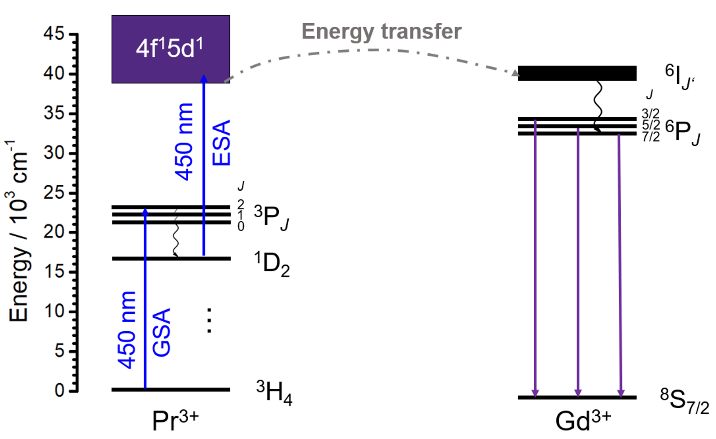Luminescent thermometers are promising candidates for non-invasive, remote, and in situ temperature sensing at the micro- and nanoscale. Potential application areas range from catalysis over microelectronics to possible sensing in biological systems. Trivalent lanthanoid ions with their narrow-line 4fn-4fn transitions in solids and their rich electronic fine structure are particularly prominent representatives in that field. Their electronic levels often have energy gaps in the order of thermal energies, which makes the intensity ratio of the light emission from the excited levels typically follow Boltzmann’s law.
The thermal bridging of only one energy gap does, however, only allow precise thermometry over a limited temperature range. This working range is thermodynamically easily extended upon usage of successively more energy gaps. Gd3+ (4f7) does offer such a desirable electronic structure and thus, allows the practical implementation of this concept in principle. However, it only absorbs very weakly in the UV range, which would require usage of expensive laser sources.
This disadvantage can be resolved by exploitation of a tricky energy transfer with the chemical relative Pr3+ (4f2): Pr3+ efficiently absorbs blue light with a wavelength of 450 nm, which is accessible cost-effectively with high intensities. By sufficiently intense excitation with high-power LEDs with blue light, Pr3+ can even be efficiently pumped into the UV range – this process is called upconversion. Finally, energy transfer to the Gd3+ ions occurs, which show the desired luminescence. By this approach, we could conceptualize a luminescent thermometer that withstands practical requirements and simultaneously works over a wide temperature range with constantly high measurement precision (between 30 K and 800 K with a stat. measurement error below 1 K).
The work is published in the renowned Nature journal Light: Science & Applications and available open access: https://doi.org/10.1038/s41377-021-00677-5


